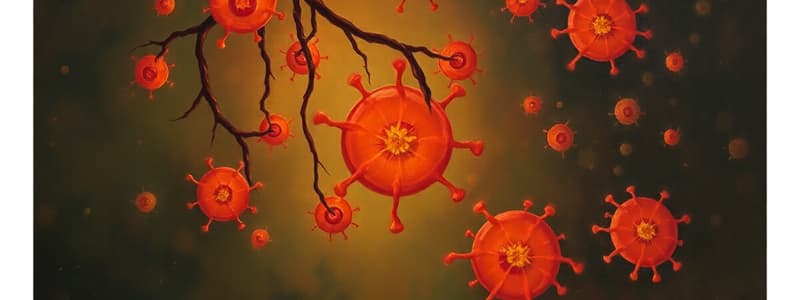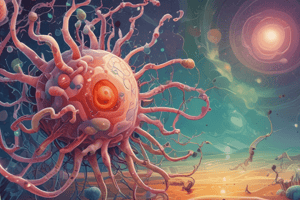Podcast
Questions and Answers
Which of the following structures help pathogens adhere to host cells?
Which of the following structures help pathogens adhere to host cells?
- Cilia
- Flagella
- Capsules
- Pili (correct)
What is the role of toxins produced by pathogens?
What is the role of toxins produced by pathogens?
- Directly damaging host cells (correct)
- Strengthening host tissues
- Facilitating nutrient absorption
- Enhancing cellular metabolism
Which virulence factor is crucial for the colonization of host tissues?
Which virulence factor is crucial for the colonization of host tissues?
- Endotoxins
- Siderophores
- Exoenzymes
- Adhesins (correct)
Which factor does Porphyromonas gingivalis utilize to modulate immune response and degrade host tissues?
Which factor does Porphyromonas gingivalis utilize to modulate immune response and degrade host tissues?
Which statement accurately describes the function of exoenzymes in pathogen virulence?
Which statement accurately describes the function of exoenzymes in pathogen virulence?
What is required for pathogens to survive apart from nutrients and protection from harmful elements?
What is required for pathogens to survive apart from nutrients and protection from harmful elements?
What type of antigenic variation results in significant changes to spike proteins through gene reassortment?
What type of antigenic variation results in significant changes to spike proteins through gene reassortment?
Which type of pathogen is normally harmless but can cause disease in an immunocompromised host?
Which type of pathogen is normally harmless but can cause disease in an immunocompromised host?
What type of pathogen can cause disease in a healthy individual?
What type of pathogen can cause disease in a healthy individual?
How can virulence factors be best described?
How can virulence factors be best described?
What are proteases, nucleases, phospholipases, and glycohydrolases classified as?
What are proteases, nucleases, phospholipases, and glycohydrolases classified as?
What can be a consequence of antigenic variation in pathogens?
What can be a consequence of antigenic variation in pathogens?
What is a primary function of virulence factors?
What is a primary function of virulence factors?
Flashcards
What is a pathogen's niche?
What is a pathogen's niche?
The establishment of a pathogen in a specific location within the host where it can access nutrients, evade immune defenses, and thrive.
What is antigenic shift?
What is antigenic shift?
A major change in the viral spike proteins usually caused by gene reassortment. This can create a new strain that the immune system doesn't recognize.
What is an opportunistic pathogen?
What is an opportunistic pathogen?
A type of microbe that is normally harmless but can cause disease when the host's immune system is compromised.
What is a primary pathogen?
What is a primary pathogen?
Signup and view all the flashcards
What are portals of entry?
What are portals of entry?
Signup and view all the flashcards
What are virulence factors?
What are virulence factors?
Signup and view all the flashcards
What are exoenzymes?
What are exoenzymes?
Signup and view all the flashcards
What is antigenic drift?
What is antigenic drift?
Signup and view all the flashcards
Adhesins
Adhesins
Signup and view all the flashcards
Exoenzymes
Exoenzymes
Signup and view all the flashcards
Toxins
Toxins
Signup and view all the flashcards
Fimbriae
Fimbriae
Signup and view all the flashcards
Gingipains
Gingipains
Signup and view all the flashcards
Study Notes
Virulence Factors
- Pathogens need nutrients, protection, and a suitable niche (site) to survive and thrive within a host.
- Access to nutrients, evading immune responses, and thriving are essential for their survival and replication.
- Some enveloped viruses use antigenic variation, making it difficult for the immune system to recognize different strains.
- Antigenic shift is a major change in viral spike proteins, often due to gene reassortment, creating a new strain the immune system may not recognize.
Opportunistic Pathogens
- Opportunistic pathogens are normally harmless members of a host's microbiota.
- They cause disease only when the host's immune system is compromised.
Primary Pathogens
- Primary pathogens can cause disease in a healthy individual.
- They typically originate outside the normal microbiota.
Virulence Factors
- Virulence factors are traits or mechanisms that help pathogens invade, infect, or cause damage to a host.
- These factors enable pathogens to establish infection and evade the host's immune response.
- Factors like proteases, nucleases, phospholipases, and glycohydrolases (exoenzymes) are secreted by pathogens, which break down host tissues, facilitating the pathogen's spread and survival.
- Adhesins (proteins F and A, pili, fimbriae) help pathogens attach to host cells.
- Toxins and exoenzymes damage host cells and tissues, contributing to disease symptoms.
- Adhesins promote pathogen colonization.
Porphyromonas Gingivalis
- Porphyromonas gingivalis utilizes fimbriae for adhesion and gingipains (exoenzymes).
- Gingipains degrade host tissues and disrupt a properly functioning immune response.
- The result is breakdown of structures around the teeth, and disregulated immunity in the gingival tissue.
Studying That Suits You
Use AI to generate personalized quizzes and flashcards to suit your learning preferences.



